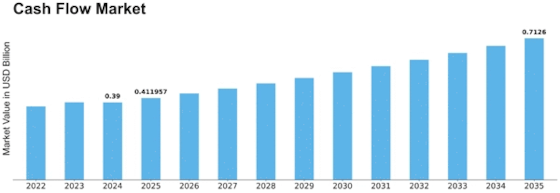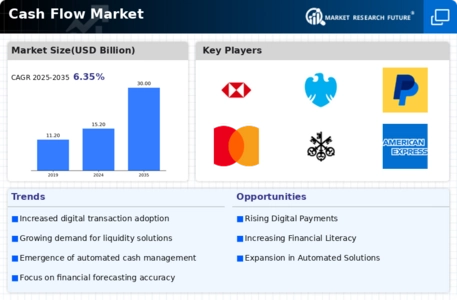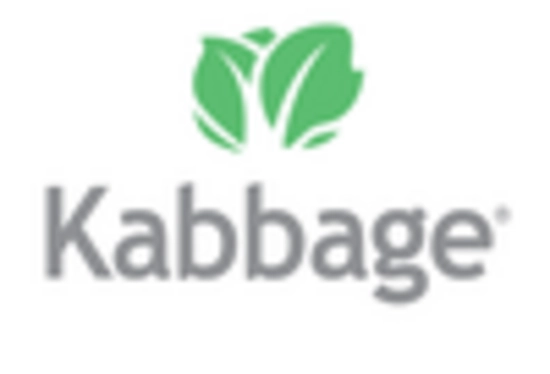-
EXECUTIVE SUMMARY
-
Market Overview
-
Key Findings
-
Market Segmentation
-
Competitive Landscape
-
Challenges and Opportunities
-
Future Outlook
-
MARKET INTRODUCTION
-
Definition
-
Scope of the study
- Research Objective
- Assumption
- Limitations
-
RESEARCH METHODOLOGY
-
Overview
-
Data Mining
-
Secondary Research
-
Primary Research
- Primary Interviews and Information Gathering Process
- Breakdown of Primary Respondents
-
Forecasting Model
-
Market Size Estimation
- Bottom-Up Approach
- Top-Down Approach
-
Data Triangulation
-
Validation
-
MARKET DYNAMICS
-
Overview
-
Drivers
-
Restraints
-
Opportunities
-
MARKET FACTOR ANALYSIS
-
Value chain Analysis
-
Porter's Five Forces Analysis
- Bargaining Power of Suppliers
- Bargaining Power of Buyers
- Threat of New Entrants
- Threat of Substitutes
- Intensity of Rivalry
-
COVID-19 Impact Analysis
- Market Impact Analysis
- Regional Impact
- Opportunity and Threat Analysis
-
CASH FLOW MARKET, BY APPLICATION (USD BILLION)
-
Personal Finance
-
Business Finance
-
Investment Analysis
-
Financial Planning
-
CASH FLOW MARKET, BY TYPE (USD BILLION)
-
Cash Management Software
-
Cash Flow Forecasting Tools
-
Cash Flow Analytics Solutions
-
CASH FLOW MARKET, BY DEPLOYMENT MODEL (USD BILLION)
-
On-Premises
-
Cloud-Based
-
Hybrid
-
CASH FLOW MARKET, BY END USE (USD BILLION)
-
Small and Medium Enterprises
-
Large Enterprises
-
Individual Users
-
CASH FLOW MARKET, BY REGIONAL (USD BILLION)
-
North America
- US
- Canada
-
Europe
- Germany
- UK
- France
- Russia
- Italy
- Spain
- Rest of Europe
-
APAC
- China
- India
- Japan
- South Korea
- Malaysia
- Thailand
- Indonesia
- Rest of APAC
-
South America
- Brazil
- Mexico
- Argentina
- Rest of South America
-
MEA
- GCC Countries
- South Africa
- Rest of MEA
-
COMPETITIVE LANDSCAPE
-
Overview
-
Competitive Analysis
-
Market share Analysis
-
Major Growth Strategy in the Cash Flow Market
-
Competitive Benchmarking
-
Leading Players in Terms of Number of Developments in the Cash Flow Market
-
Key developments and growth strategies
- New Product Launch/Service Deployment
- Merger & Acquisitions
- Joint Ventures
-
Major Players Financial Matrix
- Sales and Operating Income
- Major Players R&D Expenditure. 2023
-
COMPANY PROFILES
-
Morgan Stanley
- Financial Overview
- Products Offered
- Key Developments
- SWOT Analysis
- Key Strategies
-
JPMorgan Chase
- Financial Overview
- Products Offered
- Key Developments
- SWOT Analysis
- Key Strategies
-
Blackstone
- Financial Overview
- Products Offered
- Key Developments
- SWOT Analysis
- Key Strategies
-
Credit Suisse
- Financial Overview
- Products Offered
- Key Developments
- SWOT Analysis
- Key Strategies
-
UBS
- Financial Overview
- Products Offered
- Key Developments
- SWOT Analysis
- Key Strategies
-
HSBC
- Financial Overview
- Products Offered
- Key Developments
- SWOT Analysis
- Key Strategies
-
Deutsche Bank
- Financial Overview
- Products Offered
- Key Developments
- SWOT Analysis
- Key Strategies
-
Citigroup
- Financial Overview
- Products Offered
- Key Developments
- SWOT Analysis
- Key Strategies
-
BlackRock
- Financial Overview
- Products Offered
- Key Developments
- SWOT Analysis
- Key Strategies
-
Barclays
- Financial Overview
- Products Offered
- Key Developments
- SWOT Analysis
- Key Strategies
-
Wells Fargo
- Financial Overview
- Products Offered
- Key Developments
- SWOT Analysis
- Key Strategies
-
BNP Paribas
- Financial Overview
- Products Offered
- Key Developments
- SWOT Analysis
- Key Strategies
-
Goldman Sachs
- Financial Overview
- Products Offered
- Key Developments
- SWOT Analysis
- Key Strategies
-
State Street
- Financial Overview
- Products Offered
- Key Developments
- SWOT Analysis
- Key Strategies
-
Bank of America
- Financial Overview
- Products Offered
- Key Developments
- SWOT Analysis
- Key Strategies
-
APPENDIX
-
References
-
Related Reports
-
LIST OF TABLES
-
LIST OF ASSUMPTIONS
-
NORTH AMERICA CASH FLOW MARKET SIZE ESTIMATES & FORECAST, BY APPLICATION, 2019-2035 (USD BILLIONS)
-
NORTH AMERICA CASH FLOW MARKET SIZE ESTIMATES & FORECAST, BY TYPE, 2019-2035 (USD BILLIONS)
-
NORTH AMERICA CASH FLOW MARKET SIZE ESTIMATES & FORECAST, BY DEPLOYMENT MODEL, 2019-2035 (USD BILLIONS)
-
NORTH AMERICA CASH FLOW MARKET SIZE ESTIMATES & FORECAST, BY END USE, 2019-2035 (USD BILLIONS)
-
NORTH AMERICA CASH FLOW MARKET SIZE ESTIMATES & FORECAST, BY REGIONAL, 2019-2035 (USD BILLIONS)
-
US CASH FLOW MARKET SIZE ESTIMATES & FORECAST, BY APPLICATION, 2019-2035 (USD BILLIONS)
-
US CASH FLOW MARKET SIZE ESTIMATES & FORECAST, BY TYPE, 2019-2035 (USD BILLIONS)
-
US CASH FLOW MARKET SIZE ESTIMATES & FORECAST, BY DEPLOYMENT MODEL, 2019-2035 (USD BILLIONS)
-
US CASH FLOW MARKET SIZE ESTIMATES & FORECAST, BY END USE, 2019-2035 (USD BILLIONS)
-
US CASH FLOW MARKET SIZE ESTIMATES & FORECAST, BY REGIONAL, 2019-2035 (USD BILLIONS)
-
CANADA CASH FLOW MARKET SIZE ESTIMATES & FORECAST, BY APPLICATION, 2019-2035 (USD BILLIONS)
-
CANADA CASH FLOW MARKET SIZE ESTIMATES & FORECAST, BY TYPE, 2019-2035 (USD BILLIONS)
-
CANADA CASH FLOW MARKET SIZE ESTIMATES & FORECAST, BY DEPLOYMENT MODEL, 2019-2035 (USD BILLIONS)
-
CANADA CASH FLOW MARKET SIZE ESTIMATES & FORECAST, BY END USE, 2019-2035 (USD BILLIONS)
-
CANADA CASH FLOW MARKET SIZE ESTIMATES & FORECAST, BY REGIONAL, 2019-2035 (USD BILLIONS)
-
EUROPE CASH FLOW MARKET SIZE ESTIMATES & FORECAST, BY APPLICATION, 2019-2035 (USD BILLIONS)
-
EUROPE CASH FLOW MARKET SIZE ESTIMATES & FORECAST, BY TYPE, 2019-2035 (USD BILLIONS)
-
EUROPE CASH FLOW MARKET SIZE ESTIMATES & FORECAST, BY DEPLOYMENT MODEL, 2019-2035 (USD BILLIONS)
-
EUROPE CASH FLOW MARKET SIZE ESTIMATES & FORECAST, BY END USE, 2019-2035 (USD BILLIONS)
-
EUROPE CASH FLOW MARKET SIZE ESTIMATES & FORECAST, BY REGIONAL, 2019-2035 (USD BILLIONS)
-
GERMANY CASH FLOW MARKET SIZE ESTIMATES & FORECAST, BY APPLICATION, 2019-2035 (USD BILLIONS)
-
GERMANY CASH FLOW MARKET SIZE ESTIMATES & FORECAST, BY TYPE, 2019-2035 (USD BILLIONS)
-
GERMANY CASH FLOW MARKET SIZE ESTIMATES & FORECAST, BY DEPLOYMENT MODEL, 2019-2035 (USD BILLIONS)
-
GERMANY CASH FLOW MARKET SIZE ESTIMATES & FORECAST, BY END USE, 2019-2035 (USD BILLIONS)
-
GERMANY CASH FLOW MARKET SIZE ESTIMATES & FORECAST, BY REGIONAL, 2019-2035 (USD BILLIONS)
-
UK CASH FLOW MARKET SIZE ESTIMATES & FORECAST, BY APPLICATION, 2019-2035 (USD BILLIONS)
-
UK CASH FLOW MARKET SIZE ESTIMATES & FORECAST, BY TYPE, 2019-2035 (USD BILLIONS)
-
UK CASH FLOW MARKET SIZE ESTIMATES & FORECAST, BY DEPLOYMENT MODEL, 2019-2035 (USD BILLIONS)
-
UK CASH FLOW MARKET SIZE ESTIMATES & FORECAST, BY END USE, 2019-2035 (USD BILLIONS)
-
UK CASH FLOW MARKET SIZE ESTIMATES & FORECAST, BY REGIONAL, 2019-2035 (USD BILLIONS)
-
FRANCE CASH FLOW MARKET SIZE ESTIMATES & FORECAST, BY APPLICATION, 2019-2035 (USD BILLIONS)
-
FRANCE CASH FLOW MARKET SIZE ESTIMATES & FORECAST, BY TYPE, 2019-2035 (USD BILLIONS)
-
FRANCE CASH FLOW MARKET SIZE ESTIMATES & FORECAST, BY DEPLOYMENT MODEL, 2019-2035 (USD BILLIONS)
-
FRANCE CASH FLOW MARKET SIZE ESTIMATES & FORECAST, BY END USE, 2019-2035 (USD BILLIONS)
-
FRANCE CASH FLOW MARKET SIZE ESTIMATES & FORECAST, BY REGIONAL, 2019-2035 (USD BILLIONS)
-
RUSSIA CASH FLOW MARKET SIZE ESTIMATES & FORECAST, BY APPLICATION, 2019-2035 (USD BILLIONS)
-
RUSSIA CASH FLOW MARKET SIZE ESTIMATES & FORECAST, BY TYPE, 2019-2035 (USD BILLIONS)
-
RUSSIA CASH FLOW MARKET SIZE ESTIMATES & FORECAST, BY DEPLOYMENT MODEL, 2019-2035 (USD BILLIONS)
-
RUSSIA CASH FLOW MARKET SIZE ESTIMATES & FORECAST, BY END USE, 2019-2035 (USD BILLIONS)
-
RUSSIA CASH FLOW MARKET SIZE ESTIMATES & FORECAST, BY REGIONAL, 2019-2035 (USD BILLIONS)
-
ITALY CASH FLOW MARKET SIZE ESTIMATES & FORECAST, BY APPLICATION, 2019-2035 (USD BILLIONS)
-
ITALY CASH FLOW MARKET SIZE ESTIMATES & FORECAST, BY TYPE, 2019-2035 (USD BILLIONS)
-
ITALY CASH FLOW MARKET SIZE ESTIMATES & FORECAST, BY DEPLOYMENT MODEL, 2019-2035 (USD BILLIONS)
-
ITALY CASH FLOW MARKET SIZE ESTIMATES & FORECAST, BY END USE, 2019-2035 (USD BILLIONS)
-
ITALY CASH FLOW MARKET SIZE ESTIMATES & FORECAST, BY REGIONAL, 2019-2035 (USD BILLIONS)
-
SPAIN CASH FLOW MARKET SIZE ESTIMATES & FORECAST, BY APPLICATION, 2019-2035 (USD BILLIONS)
-
SPAIN CASH FLOW MARKET SIZE ESTIMATES & FORECAST, BY TYPE, 2019-2035 (USD BILLIONS)
-
SPAIN CASH FLOW MARKET SIZE ESTIMATES & FORECAST, BY DEPLOYMENT MODEL, 2019-2035 (USD BILLIONS)
-
SPAIN CASH FLOW MARKET SIZE ESTIMATES & FORECAST, BY END USE, 2019-2035 (USD BILLIONS)
-
SPAIN CASH FLOW MARKET SIZE ESTIMATES & FORECAST, BY REGIONAL, 2019-2035 (USD BILLIONS)
-
REST OF EUROPE CASH FLOW MARKET SIZE ESTIMATES & FORECAST, BY APPLICATION, 2019-2035 (USD BILLIONS)
-
REST OF EUROPE CASH FLOW MARKET SIZE ESTIMATES & FORECAST, BY TYPE, 2019-2035 (USD BILLIONS)
-
REST OF EUROPE CASH FLOW MARKET SIZE ESTIMATES & FORECAST, BY DEPLOYMENT MODEL, 2019-2035 (USD BILLIONS)
-
REST OF EUROPE CASH FLOW MARKET SIZE ESTIMATES & FORECAST, BY END USE, 2019-2035 (USD BILLIONS)
-
REST OF EUROPE CASH FLOW MARKET SIZE ESTIMATES & FORECAST, BY REGIONAL, 2019-2035 (USD BILLIONS)
-
APAC CASH FLOW MARKET SIZE ESTIMATES & FORECAST, BY APPLICATION, 2019-2035 (USD BILLIONS)
-
APAC CASH FLOW MARKET SIZE ESTIMATES & FORECAST, BY TYPE, 2019-2035 (USD BILLIONS)
-
APAC CASH FLOW MARKET SIZE ESTIMATES & FORECAST, BY DEPLOYMENT MODEL, 2019-2035 (USD BILLIONS)
-
APAC CASH FLOW MARKET SIZE ESTIMATES & FORECAST, BY END USE, 2019-2035 (USD BILLIONS)
-
APAC CASH FLOW MARKET SIZE ESTIMATES & FORECAST, BY REGIONAL, 2019-2035 (USD BILLIONS)
-
CHINA CASH FLOW MARKET SIZE ESTIMATES & FORECAST, BY APPLICATION, 2019-2035 (USD BILLIONS)
-
CHINA CASH FLOW MARKET SIZE ESTIMATES & FORECAST, BY TYPE, 2019-2035 (USD BILLIONS)
-
CHINA CASH FLOW MARKET SIZE ESTIMATES & FORECAST, BY DEPLOYMENT MODEL, 2019-2035 (USD BILLIONS)
-
CHINA CASH FLOW MARKET SIZE ESTIMATES & FORECAST, BY END USE, 2019-2035 (USD BILLIONS)
-
CHINA CASH FLOW MARKET SIZE ESTIMATES & FORECAST, BY REGIONAL, 2019-2035 (USD BILLIONS)
-
INDIA CASH FLOW MARKET SIZE ESTIMATES & FORECAST, BY APPLICATION, 2019-2035 (USD BILLIONS)
-
INDIA CASH FLOW MARKET SIZE ESTIMATES & FORECAST, BY TYPE, 2019-2035 (USD BILLIONS)
-
INDIA CASH FLOW MARKET SIZE ESTIMATES & FORECAST, BY DEPLOYMENT MODEL, 2019-2035 (USD BILLIONS)
-
INDIA CASH FLOW MARKET SIZE ESTIMATES & FORECAST, BY END USE, 2019-2035 (USD BILLIONS)
-
INDIA CASH FLOW MARKET SIZE ESTIMATES & FORECAST, BY REGIONAL, 2019-2035 (USD BILLIONS)
-
JAPAN CASH FLOW MARKET SIZE ESTIMATES & FORECAST, BY APPLICATION, 2019-2035 (USD BILLIONS)
-
JAPAN CASH FLOW MARKET SIZE ESTIMATES & FORECAST, BY TYPE, 2019-2035 (USD BILLIONS)
-
JAPAN CASH FLOW MARKET SIZE ESTIMATES & FORECAST, BY DEPLOYMENT MODEL, 2019-2035 (USD BILLIONS)
-
JAPAN CASH FLOW MARKET SIZE ESTIMATES & FORECAST, BY END USE, 2019-2035 (USD BILLIONS)
-
JAPAN CASH FLOW MARKET SIZE ESTIMATES & FORECAST, BY REGIONAL, 2019-2035 (USD BILLIONS)
-
SOUTH KOREA CASH FLOW MARKET SIZE ESTIMATES & FORECAST, BY APPLICATION, 2019-2035 (USD BILLIONS)
-
SOUTH KOREA CASH FLOW MARKET SIZE ESTIMATES & FORECAST, BY TYPE, 2019-2035 (USD BILLIONS)
-
SOUTH KOREA CASH FLOW MARKET SIZE ESTIMATES & FORECAST, BY DEPLOYMENT MODEL, 2019-2035 (USD BILLIONS)
-
SOUTH KOREA CASH FLOW MARKET SIZE ESTIMATES & FORECAST, BY END USE, 2019-2035 (USD BILLIONS)
-
SOUTH KOREA CASH FLOW MARKET SIZE ESTIMATES & FORECAST, BY REGIONAL, 2019-2035 (USD BILLIONS)
-
MALAYSIA CASH FLOW MARKET SIZE ESTIMATES & FORECAST, BY APPLICATION, 2019-2035 (USD BILLIONS)
-
MALAYSIA CASH FLOW MARKET SIZE ESTIMATES & FORECAST, BY TYPE, 2019-2035 (USD BILLIONS)
-
MALAYSIA CASH FLOW MARKET SIZE ESTIMATES & FORECAST, BY DEPLOYMENT MODEL, 2019-2035 (USD BILLIONS)
-
MALAYSIA CASH FLOW MARKET SIZE ESTIMATES & FORECAST, BY END USE, 2019-2035 (USD BILLIONS)
-
MALAYSIA CASH FLOW MARKET SIZE ESTIMATES & FORECAST, BY REGIONAL, 2019-2035 (USD BILLIONS)
-
THAILAND CASH FLOW MARKET SIZE ESTIMATES & FORECAST, BY APPLICATION, 2019-2035 (USD BILLIONS)
-
THAILAND CASH FLOW MARKET SIZE ESTIMATES & FORECAST, BY TYPE, 2019-2035 (USD BILLIONS)
-
THAILAND CASH FLOW MARKET SIZE ESTIMATES & FORECAST, BY DEPLOYMENT MODEL, 2019-2035 (USD BILLIONS)
-
THAILAND CASH FLOW MARKET SIZE ESTIMATES & FORECAST, BY END USE, 2019-2035 (USD BILLIONS)
-
THAILAND CASH FLOW MARKET SIZE ESTIMATES & FORECAST, BY REGIONAL, 2019-2035 (USD BILLIONS)
-
INDONESIA CASH FLOW MARKET SIZE ESTIMATES & FORECAST, BY APPLICATION, 2019-2035 (USD BILLIONS)
-
INDONESIA CASH FLOW MARKET SIZE ESTIMATES & FORECAST, BY TYPE, 2019-2035 (USD BILLIONS)
-
INDONESIA CASH FLOW MARKET SIZE ESTIMATES & FORECAST, BY DEPLOYMENT MODEL, 2019-2035 (USD BILLIONS)
-
INDONESIA CASH FLOW MARKET SIZE ESTIMATES & FORECAST, BY END USE, 2019-2035 (USD BILLIONS)
-
INDONESIA CASH FLOW MARKET SIZE ESTIMATES & FORECAST, BY REGIONAL, 2019-2035 (USD BILLIONS)
-
REST OF APAC CASH FLOW MARKET SIZE ESTIMATES & FORECAST, BY APPLICATION, 2019-2035 (USD BILLIONS)
-
REST OF APAC CASH FLOW MARKET SIZE ESTIMATES & FORECAST, BY TYPE, 2019-2035 (USD BILLIONS)
-
REST OF APAC CASH FLOW MARKET SIZE ESTIMATES & FORECAST, BY DEPLOYMENT MODEL, 2019-2035 (USD BILLIONS)
-
REST OF APAC CASH FLOW MARKET SIZE ESTIMATES & FORECAST, BY END USE, 2019-2035 (USD BILLIONS)
-
REST OF APAC CASH FLOW MARKET SIZE ESTIMATES & FORECAST, BY REGIONAL, 2019-2035 (USD BILLIONS)
-
SOUTH AMERICA CASH FLOW MARKET SIZE ESTIMATES & FORECAST, BY APPLICATION, 2019-2035 (USD BILLIONS)
-
SOUTH AMERICA CASH FLOW MARKET SIZE ESTIMATES & FORECAST, BY TYPE, 2019-2035 (USD BILLIONS)
-
SOUTH AMERICA CASH FLOW MARKET SIZE ESTIMATES & FORECAST, BY DEPLOYMENT MODEL, 2019-2035 (USD BILLIONS)
-
SOUTH AMERICA CASH FLOW MARKET SIZE ESTIMATES & FORECAST, BY END USE, 2019-2035 (USD BILLIONS)
-
SOUTH AMERICA CASH FLOW MARKET SIZE ESTIMATES & FORECAST, BY REGIONAL, 2019-2035 (USD BILLIONS)
-
BRAZIL CASH FLOW MARKET SIZE ESTIMATES & FORECAST, BY APPLICATION, 2019-2035 (USD BILLIONS)
-
BRAZIL CASH FLOW MARKET SIZE ESTIMATES & FORECAST, BY TYPE, 2019-2035 (USD BILLIONS)
-
BRAZIL CASH FLOW MARKET SIZE ESTIMATES & FORECAST, BY DEPLOYMENT MODEL, 2019-2035 (USD BILLIONS)
-
BRAZIL CASH FLOW MARKET SIZE ESTIMATES & FORECAST, BY END USE, 2019-2035 (USD BILLIONS)
-
BRAZIL CASH FLOW MARKET SIZE ESTIMATES & FORECAST, BY REGIONAL, 2019-2035 (USD BILLIONS)
-
MEXICO CASH FLOW MARKET SIZE ESTIMATES & FORECAST, BY APPLICATION, 2019-2035 (USD BILLIONS)
-
MEXICO CASH FLOW MARKET SIZE ESTIMATES & FORECAST, BY TYPE, 2019-2035 (USD BILLIONS)
-
MEXICO CASH FLOW MARKET SIZE ESTIMATES & FORECAST, BY DEPLOYMENT MODEL, 2019-2035 (USD BILLIONS)
-
MEXICO CASH FLOW MARKET SIZE ESTIMATES & FORECAST, BY END USE, 2019-2035 (USD BILLIONS)
-
MEXICO CASH FLOW MARKET SIZE ESTIMATES & FORECAST, BY REGIONAL, 2019-2035 (USD BILLIONS)
-
ARGENTINA CASH FLOW MARKET SIZE ESTIMATES & FORECAST, BY APPLICATION, 2019-2035 (USD BILLIONS)
-
ARGENTINA CASH FLOW MARKET SIZE ESTIMATES & FORECAST, BY TYPE, 2019-2035 (USD BILLIONS)
-
ARGENTINA CASH FLOW MARKET SIZE ESTIMATES & FORECAST, BY DEPLOYMENT MODEL, 2019-2035 (USD BILLIONS)
-
ARGENTINA CASH FLOW MARKET SIZE ESTIMATES & FORECAST, BY END USE, 2019-2035 (USD BILLIONS)
-
ARGENTINA CASH FLOW MARKET SIZE ESTIMATES & FORECAST, BY REGIONAL, 2019-2035 (USD BILLIONS)
-
REST OF SOUTH AMERICA CASH FLOW MARKET SIZE ESTIMATES & FORECAST, BY APPLICATION, 2019-2035 (USD BILLIONS)
-
REST OF SOUTH AMERICA CASH FLOW MARKET SIZE ESTIMATES & FORECAST, BY TYPE, 2019-2035 (USD BILLIONS)
-
REST OF SOUTH AMERICA CASH FLOW MARKET SIZE ESTIMATES & FORECAST, BY DEPLOYMENT MODEL, 2019-2035 (USD BILLIONS)
-
REST OF SOUTH AMERICA CASH FLOW MARKET SIZE ESTIMATES & FORECAST, BY END USE, 2019-2035 (USD BILLIONS)
-
REST OF SOUTH AMERICA CASH FLOW MARKET SIZE ESTIMATES & FORECAST, BY REGIONAL, 2019-2035 (USD BILLIONS)
-
MEA CASH FLOW MARKET SIZE ESTIMATES & FORECAST, BY APPLICATION, 2019-2035 (USD BILLIONS)
-
MEA CASH FLOW MARKET SIZE ESTIMATES & FORECAST, BY TYPE, 2019-2035 (USD BILLIONS)
-
MEA CASH FLOW MARKET SIZE ESTIMATES & FORECAST, BY DEPLOYMENT MODEL, 2019-2035 (USD BILLIONS)
-
MEA CASH FLOW MARKET SIZE ESTIMATES & FORECAST, BY END USE, 2019-2035 (USD BILLIONS)
-
MEA CASH FLOW MARKET SIZE ESTIMATES & FORECAST, BY REGIONAL, 2019-2035 (USD BILLIONS)
-
GCC COUNTRIES CASH FLOW MARKET SIZE ESTIMATES & FORECAST, BY APPLICATION, 2019-2035 (USD BILLIONS)
-
GCC COUNTRIES CASH FLOW MARKET SIZE ESTIMATES & FORECAST, BY TYPE, 2019-2035 (USD BILLIONS)
-
GCC COUNTRIES CASH FLOW MARKET SIZE ESTIMATES & FORECAST, BY DEPLOYMENT MODEL, 2019-2035 (USD BILLIONS)
-
GCC COUNTRIES CASH FLOW MARKET SIZE ESTIMATES & FORECAST, BY END USE, 2019-2035 (USD BILLIONS)
-
GCC COUNTRIES CASH FLOW MARKET SIZE ESTIMATES & FORECAST, BY REGIONAL, 2019-2035 (USD BILLIONS)
-
SOUTH AFRICA CASH FLOW MARKET SIZE ESTIMATES & FORECAST, BY APPLICATION, 2019-2035 (USD BILLIONS)
-
SOUTH AFRICA CASH FLOW MARKET SIZE ESTIMATES & FORECAST, BY TYPE, 2019-2035 (USD BILLIONS)
-
SOUTH AFRICA CASH FLOW MARKET SIZE ESTIMATES & FORECAST, BY DEPLOYMENT MODEL, 2019-2035 (USD BILLIONS)
-
SOUTH AFRICA CASH FLOW MARKET SIZE ESTIMATES & FORECAST, BY END USE, 2019-2035 (USD BILLIONS)
-
SOUTH AFRICA CASH FLOW MARKET SIZE ESTIMATES & FORECAST, BY REGIONAL, 2019-2035 (USD BILLIONS)
-
REST OF MEA CASH FLOW MARKET SIZE ESTIMATES & FORECAST, BY APPLICATION, 2019-2035 (USD BILLIONS)
-
REST OF MEA CASH FLOW MARKET SIZE ESTIMATES & FORECAST, BY TYPE, 2019-2035 (USD BILLIONS)
-
REST OF MEA CASH FLOW MARKET SIZE ESTIMATES & FORECAST, BY DEPLOYMENT MODEL, 2019-2035 (USD BILLIONS)
-
REST OF MEA CASH FLOW MARKET SIZE ESTIMATES & FORECAST, BY END USE, 2019-2035 (USD BILLIONS)
-
REST OF MEA CASH FLOW MARKET SIZE ESTIMATES & FORECAST, BY REGIONAL, 2019-2035 (USD BILLIONS)
-
PRODUCT LAUNCH/PRODUCT DEVELOPMENT/APPROVAL
-
ACQUISITION/PARTNERSHIP
-
LIST OF FIGURES
-
MARKET SYNOPSIS
-
NORTH AMERICA CASH FLOW MARKET ANALYSIS
-
US CASH FLOW MARKET ANALYSIS BY APPLICATION
-
US CASH FLOW MARKET ANALYSIS BY TYPE
-
US CASH FLOW MARKET ANALYSIS BY DEPLOYMENT MODEL
-
US CASH FLOW MARKET ANALYSIS BY END USE
-
US CASH FLOW MARKET ANALYSIS BY REGIONAL
-
CANADA CASH FLOW MARKET ANALYSIS BY APPLICATION
-
CANADA CASH FLOW MARKET ANALYSIS BY TYPE
-
CANADA CASH FLOW MARKET ANALYSIS BY DEPLOYMENT MODEL
-
CANADA CASH FLOW MARKET ANALYSIS BY END USE
-
CANADA CASH FLOW MARKET ANALYSIS BY REGIONAL
-
EUROPE CASH FLOW MARKET ANALYSIS
-
GERMANY CASH FLOW MARKET ANALYSIS BY APPLICATION
-
GERMANY CASH FLOW MARKET ANALYSIS BY TYPE
-
GERMANY CASH FLOW MARKET ANALYSIS BY DEPLOYMENT MODEL
-
GERMANY CASH FLOW MARKET ANALYSIS BY END USE
-
GERMANY CASH FLOW MARKET ANALYSIS BY REGIONAL
-
UK CASH FLOW MARKET ANALYSIS BY APPLICATION
-
UK CASH FLOW MARKET ANALYSIS BY TYPE
-
UK CASH FLOW MARKET ANALYSIS BY DEPLOYMENT MODEL
-
UK CASH FLOW MARKET ANALYSIS BY END USE
-
UK CASH FLOW MARKET ANALYSIS BY REGIONAL
-
FRANCE CASH FLOW MARKET ANALYSIS BY APPLICATION
-
FRANCE CASH FLOW MARKET ANALYSIS BY TYPE
-
FRANCE CASH FLOW MARKET ANALYSIS BY DEPLOYMENT MODEL
-
FRANCE CASH FLOW MARKET ANALYSIS BY END USE
-
FRANCE CASH FLOW MARKET ANALYSIS BY REGIONAL
-
RUSSIA CASH FLOW MARKET ANALYSIS BY APPLICATION
-
RUSSIA CASH FLOW MARKET ANALYSIS BY TYPE
-
RUSSIA CASH FLOW MARKET ANALYSIS BY DEPLOYMENT MODEL
-
RUSSIA CASH FLOW MARKET ANALYSIS BY END USE
-
RUSSIA CASH FLOW MARKET ANALYSIS BY REGIONAL
-
ITALY CASH FLOW MARKET ANALYSIS BY APPLICATION
-
ITALY CASH FLOW MARKET ANALYSIS BY TYPE
-
ITALY CASH FLOW MARKET ANALYSIS BY DEPLOYMENT MODEL
-
ITALY CASH FLOW MARKET ANALYSIS BY END USE
-
ITALY CASH FLOW MARKET ANALYSIS BY REGIONAL
-
SPAIN CASH FLOW MARKET ANALYSIS BY APPLICATION
-
SPAIN CASH FLOW MARKET ANALYSIS BY TYPE
-
SPAIN CASH FLOW MARKET ANALYSIS BY DEPLOYMENT MODEL
-
SPAIN CASH FLOW MARKET ANALYSIS BY END USE
-
SPAIN CASH FLOW MARKET ANALYSIS BY REGIONAL
-
REST OF EUROPE CASH FLOW MARKET ANALYSIS BY APPLICATION
-
REST OF EUROPE CASH FLOW MARKET ANALYSIS BY TYPE
-
REST OF EUROPE CASH FLOW MARKET ANALYSIS BY DEPLOYMENT MODEL
-
REST OF EUROPE CASH FLOW MARKET ANALYSIS BY END USE
-
REST OF EUROPE CASH FLOW MARKET ANALYSIS BY REGIONAL
-
APAC CASH FLOW MARKET ANALYSIS
-
CHINA CASH FLOW MARKET ANALYSIS BY APPLICATION
-
CHINA CASH FLOW MARKET ANALYSIS BY TYPE
-
CHINA CASH FLOW MARKET ANALYSIS BY DEPLOYMENT MODEL
-
CHINA CASH FLOW MARKET ANALYSIS BY END USE
-
CHINA CASH FLOW MARKET ANALYSIS BY REGIONAL
-
INDIA CASH FLOW MARKET ANALYSIS BY APPLICATION
-
INDIA CASH FLOW MARKET ANALYSIS BY TYPE
-
INDIA CASH FLOW MARKET ANALYSIS BY DEPLOYMENT MODEL
-
INDIA CASH FLOW MARKET ANALYSIS BY END USE
-
INDIA CASH FLOW MARKET ANALYSIS BY REGIONAL
-
JAPAN CASH FLOW MARKET ANALYSIS BY APPLICATION
-
JAPAN CASH FLOW MARKET ANALYSIS BY TYPE
-
JAPAN CASH FLOW MARKET ANALYSIS BY DEPLOYMENT MODEL
-
JAPAN CASH FLOW MARKET ANALYSIS BY END USE
-
JAPAN CASH FLOW MARKET ANALYSIS BY REGIONAL
-
SOUTH KOREA CASH FLOW MARKET ANALYSIS BY APPLICATION
-
SOUTH KOREA CASH FLOW MARKET ANALYSIS BY TYPE
-
SOUTH KOREA CASH FLOW MARKET ANALYSIS BY DEPLOYMENT MODEL
-
SOUTH KOREA CASH FLOW MARKET ANALYSIS BY END USE
-
SOUTH KOREA CASH FLOW MARKET ANALYSIS BY REGIONAL
-
MALAYSIA CASH FLOW MARKET ANALYSIS BY APPLICATION
-
MALAYSIA CASH FLOW MARKET ANALYSIS BY TYPE
-
MALAYSIA CASH FLOW MARKET ANALYSIS BY DEPLOYMENT MODEL
-
MALAYSIA CASH FLOW MARKET ANALYSIS BY END USE
-
MALAYSIA CASH FLOW MARKET ANALYSIS BY REGIONAL
-
THAILAND CASH FLOW MARKET ANALYSIS BY APPLICATION
-
THAILAND CASH FLOW MARKET ANALYSIS BY TYPE
-
THAILAND CASH FLOW MARKET ANALYSIS BY DEPLOYMENT MODEL
-
THAILAND CASH FLOW MARKET ANALYSIS BY END USE
-
THAILAND CASH FLOW MARKET ANALYSIS BY REGIONAL
-
INDONESIA CASH FLOW MARKET ANALYSIS BY APPLICATION
-
INDONESIA CASH FLOW MARKET ANALYSIS BY TYPE
-
INDONESIA CASH FLOW MARKET ANALYSIS BY DEPLOYMENT MODEL
-
INDONESIA CASH FLOW MARKET ANALYSIS BY END USE
-
INDONESIA CASH FLOW MARKET ANALYSIS BY REGIONAL
-
REST OF APAC CASH FLOW MARKET ANALYSIS BY APPLICATION
-
REST OF APAC CASH FLOW MARKET ANALYSIS BY TYPE
-
REST OF APAC CASH FLOW MARKET ANALYSIS BY DEPLOYMENT MODEL
-
REST OF APAC CASH FLOW MARKET ANALYSIS BY END USE
-
REST OF APAC CASH FLOW MARKET ANALYSIS BY REGIONAL
-
SOUTH AMERICA CASH FLOW MARKET ANALYSIS
-
BRAZIL CASH FLOW MARKET ANALYSIS BY APPLICATION
-
BRAZIL CASH FLOW MARKET ANALYSIS BY TYPE
-
BRAZIL CASH FLOW MARKET ANALYSIS BY DEPLOYMENT MODEL
-
BRAZIL CASH FLOW MARKET ANALYSIS BY END USE
-
BRAZIL CASH FLOW MARKET ANALYSIS BY REGIONAL
-
MEXICO CASH FLOW MARKET ANALYSIS BY APPLICATION
-
MEXICO CASH FLOW MARKET ANALYSIS BY TYPE
-
MEXICO CASH FLOW MARKET ANALYSIS BY DEPLOYMENT MODEL
-
MEXICO CASH FLOW MARKET ANALYSIS BY END USE
-
MEXICO CASH FLOW MARKET ANALYSIS BY REGIONAL
-
ARGENTINA CASH FLOW MARKET ANALYSIS BY APPLICATION
-
ARGENTINA CASH FLOW MARKET ANALYSIS BY TYPE
-
ARGENTINA CASH FLOW MARKET ANALYSIS BY DEPLOYMENT MODEL
-
ARGENTINA CASH FLOW MARKET ANALYSIS BY END USE
-
ARGENTINA CASH FLOW MARKET ANALYSIS BY REGIONAL
-
REST OF SOUTH AMERICA CASH FLOW MARKET ANALYSIS BY APPLICATION
-
REST OF SOUTH AMERICA CASH FLOW MARKET ANALYSIS BY TYPE
-
REST OF SOUTH AMERICA CASH FLOW MARKET ANALYSIS BY DEPLOYMENT MODEL
-
REST OF SOUTH AMERICA CASH FLOW MARKET ANALYSIS BY END USE
-
REST OF SOUTH AMERICA CASH FLOW MARKET ANALYSIS BY REGIONAL
-
MEA CASH FLOW MARKET ANALYSIS
-
GCC COUNTRIES CASH FLOW MARKET ANALYSIS BY APPLICATION
-
GCC COUNTRIES CASH FLOW MARKET ANALYSIS BY TYPE
-
GCC COUNTRIES CASH FLOW MARKET ANALYSIS BY DEPLOYMENT MODEL
-
GCC COUNTRIES CASH FLOW MARKET ANALYSIS BY END USE
-
GCC COUNTRIES CASH FLOW MARKET ANALYSIS BY REGIONAL
-
SOUTH AFRICA CASH FLOW MARKET ANALYSIS BY APPLICATION
-
SOUTH AFRICA CASH FLOW MARKET ANALYSIS BY TYPE
-
SOUTH AFRICA CASH FLOW MARKET ANALYSIS BY DEPLOYMENT MODEL
-
SOUTH AFRICA CASH FLOW MARKET ANALYSIS BY END USE
-
SOUTH AFRICA CASH FLOW MARKET ANALYSIS BY REGIONAL
-
REST OF MEA CASH FLOW MARKET ANALYSIS BY APPLICATION
-
REST OF MEA CASH FLOW MARKET ANALYSIS BY TYPE
-
REST OF MEA CASH FLOW MARKET ANALYSIS BY DEPLOYMENT MODEL
-
REST OF MEA CASH FLOW MARKET ANALYSIS BY END USE
-
REST OF MEA CASH FLOW MARKET ANALYSIS BY REGIONAL
-
KEY BUYING CRITERIA OF CASH FLOW MARKET
-
RESEARCH PROCESS OF MRFR
-
DRO ANALYSIS OF CASH FLOW MARKET
-
DRIVERS IMPACT ANALYSIS: CASH FLOW MARKET
-
RESTRAINTS IMPACT ANALYSIS: CASH FLOW MARKET
-
SUPPLY / VALUE CHAIN: CASH FLOW MARKET
-
CASH FLOW MARKET, BY APPLICATION, 2025 (% SHARE)
-
CASH FLOW MARKET, BY APPLICATION, 2019 TO 2035 (USD Billions)
-
CASH FLOW MARKET, BY TYPE, 2025 (% SHARE)
-
CASH FLOW MARKET, BY TYPE, 2019 TO 2035 (USD Billions)
-
CASH FLOW MARKET, BY DEPLOYMENT MODEL, 2025 (% SHARE)
-
CASH FLOW MARKET, BY DEPLOYMENT MODEL, 2019 TO 2035 (USD Billions)
-
CASH FLOW MARKET, BY END USE, 2025 (% SHARE)
-
CASH FLOW MARKET, BY END USE, 2019 TO 2035 (USD Billions)
-
CASH FLOW MARKET, BY REGIONAL, 2025 (% SHARE)
-
CASH FLOW MARKET, BY REGIONAL, 2019 TO 2035 (USD Billions)
-
BENCHMARKING OF MAJOR COMPETITORS
-
"










Leave a Comment